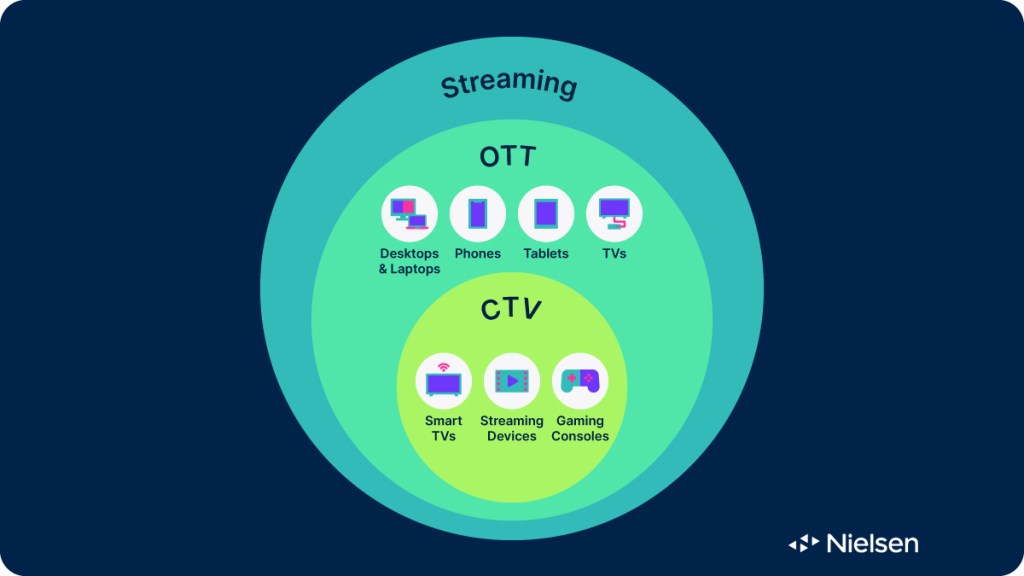If there’s one thing the media industry loves, it’s an acronym.
Letters run rampant across media plans, presentation decks and press releases. But as new media types emerge—along with their subsequent short-hand—distinctions get lost in the mix. When talking about online media, three terms in particular get confused.
We break down the differences between OTT, CTV and streaming, how advertising works on each, and why they’re more critical than ever for marketers to understand.
How are OTT, CTV and streaming defined?

• Streaming — An umbrella term that describes audio and video content delivery to a user’s device through the internet. You can “stream” content across any device.
• Over-the-top (OTT) — The method of streaming content “over the top” of the internet across any device. OTT streaming requires a strong internet connection and a device that supports apps or browsers. OTT used to refer to only video content but now it’s expanded to include all the internet offers.
So, when you watch a rerun of Friends on your TV via cable, you are not watching OTT. However, if you switch over to your Apple TV system, open the HBO Max app, and begin streaming Friends, then you are watching OTT. The difference has to do with how you’re accessing the content, rather than what the content is.
• Connected TV (CTV) — The method of streaming content from the internet on a television screen. A standard television can become a connected TV via a streaming device, like a Roku or Amazon Fire TV stick, or through a gaming console, like a PlayStation or Xbox. It can also come with internet connectivity built in, in which case it would be called a smart TV.
The difference between OTT and CTV is particularly confusing, so it’s worth reiterating that CTV refers to the television device itself.
Are there other kinds of streaming TV?
OTT and CTV sit at the top of their own acronym iceberg. That’s because there are several subcategories marketers should understand.

- Subscription Video On Demand (SVOD) — Audiences pay a monthly or yearly rate to access content, typically without ads. SVOD services include Netflix, Disney+ and HBO Max.
- Advertising-based Video On Demand (AVOD) — Audiences access AVOD content for free (or at a reduced rate) in exchange for watching ads. Many SVOD services now offer an AVOD tier. AVOD services include Tubi, VEVO, and PlutoTV.
- Transactional Video On Demand (TVOD) — Audiences access TVOD content on a pay-per-view basis. AVOD services include Google Play, iTunes and Vimeo.
Wait, there’s more! Streaming services are now making room for linear TV, too. Linear TV refers to scheduled programming that is accessed through a satellite or cable network. These services, in particular, are rising in popularity as viewers have to sift through more content and platform choices than ever.

- Free Ad-supported Streaming Television (FAST) — An app, service or channel that streams scheduled programming—similar to a linear TV experience—through a connected device. FAST services include The Roku Channel, Tubi and Amazon Freevee.
- Virtual Multichannel Video Programming Distributors (vMVPD) — Services providers that bundle and deliver multiple channels to subscribers over the internet. vMVPD services include YouTube TV, Sling TV and Hulu + Live TV.
How are ad experiences different across OTT and CTV devices?
Remember, when we talk about CTV, we’re always talking about the TV screen. OTT refers to CTV plus desktop, mobile and tablet streaming. So, naturally, that means CTV devices and all other OTT devices have both distinct and overlapping ad experiences.
Streaming Ad Advantages
- Precision: Streaming advertising can tap into the detailed user data consistently available on mobile, tablet and desktop devices, allowing for more advanced targeting, less waste and better understanding of performance.
- Costs: Smaller screens and lower engagement mean OTT ad spots are typically cheaper than other TV buys, including CTV.
- Interactivity: With user actions just a click or swipe away, viewers can be directed straight to a brand’s website or app, creating one-step user journeys on platforms that support this functionality
CTV Ad Advantages
- Engagement: Unlike other OTT devices, most CTV ads are unskippable, and ad segments are generally shorter than those on linear TV and less likely to drive someone from the room.
- Resilience: Individual user tracking is uncommon, which has forced a reliance on aggregated household data and context clues. While this has limited targeting capabilities, it’s also set CTV to thrive in a world without cookies.
- Co-viewing: TV screens are typically much larger than other OTT devices. Bigger screens, particularly in communal spaces around the home, create ad environments much more conducive for groups to watch them and not just individuals.
Ad Obstacles For Both
- Transparency: Whether buying directly from streaming providers, programmatically, or through resellers, advertisers often can’t choose or don’t know which content their ads will surround.
- Fragmentation: While buying at the platform or program level offers more control, it multiplies the datasets and measurement methodologies. Without a set of common metrics, marketers have a hard time extrapolating holistic performance
- Fraud: The streaming ecosystem doesn’t yet have consistent measurement standards, user or device IDs, making it ripe for fraudulent activity.
Both CTV and broader OTT channels have clear strengths, but rarely do marketers need to choose sides. They work best when they work together, creating a multi-channel strategy that accounts for the viewer’s full streaming experience.
What’s driving the streaming surge?
What started as niche corner in the media landscape in the early 2000s has grown to the dominant form of TV viewing in the U.S.1 And streaming’s trend line isn’t likely to dip down anytime soon for a few reasons:
- Younger viewers (18-34) spend considerably more time with streaming2 than any other TV source
- Major streaming players like Amazon Prime Video, Netflix and Peacock are investing in sports and live event programming, the last bastions of appointment TV
- FAST streaming channels offer a familiar linear viewing experience without having to choose when or what to watch after picking a channel.
What started as niche corner in the media landscape in the early 2000s has grown to the dominant form of TV viewing in the U.S.
Growing CTV reach and usage is also supercharging the streaming boom. The reach of CTV devices in the U.S. has jumped to 75%, up from 58% at the start of 2020. Smart TVs, which often come pre-installed streaming apps, are nearing ubiquity3 in the U.S. And it’s not a U.S. only phenomenon. In Australia, 90%4 of the population 14 and older steam OTT content.
What could block streaming’s growth?
While the numbers prove things are still sunny for streaming, there may be clouds on the horizon. Consumers used to get away with subscribing to about three streaming services. But as new players enter the field and monthly costs go up, streaming has started feeling like a more complicated and costly version of cable.
Cheaper, ad-supported tiers now available on most major platforms offer more choice for viewers and opportunities for advertisers, but targeting, attribution and unified measurement get in the way of CTV and OTT’s maximum potential. At Nielsen, we believe the solution is person-level measurement to identify who is watching, what they’re watching and how they act in the real world.
Another big thing streaming marketers will contend with for the next several years is evolving privacy regulations. Every new channel enjoys its wild west days of experimentation, but as CTV grabs more share of ad spend, scrutiny around data usage will follow.
We have thoughts on how to solve for that, too. Big data, validated by representative person-level panels, provides the most accurate view of an audience. It has the dual benefit of ensuring a privacy-safe solution for marketers across OTT and CTV channels.
What is TV’s future?
Right now, television is viewed through a binary: linear and streaming. But as we move towards a near complete digitization of TV, those once-crisp lines are blurring, fast. How we define terms like OTT, CTV and even TV may change. New channels will rise, behaviors will shift.
What won’t budge is marketers desire to know and go where audiences are. And to do that, the industry will need reliable measurement and metrics that work everywhere audiences find themselves—today and tomorrow.
Nielsen’s Need to Know reviews the fundamentals of audience measurement and demystifies the media industry’s hottest topics. Read every article here.
Notes
1As of November 2023, streaming (whether from digital-first or legacy TV companies) accounted for nearly 40% of total TV minutes according to Nielsen’s The Gauge.
260% of time spent with TV is on streaming for audiences 18-34 according to Nielsen’s 2024 Upfronts/NewFronts Planning Guide.
3As of 2023, Smart TV penetration is 70.6% among U.S. TV homes according to Nielsen’s National TV Panel
42023 S08 National Survey, September-October



